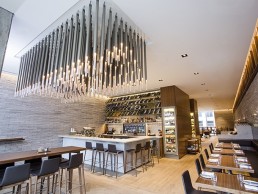
Buca Restaurant, Canada
VISO has lit up Costantino Studio’s vision of a third Buca restaurant in Toronto, Canada. Honest materials and an elegant touch were used to create authentic Italian style.
A third location of Buca Restaurants is now open at the foot of the Four Seasons in Yorkville, Toronto, Canada. Owned by Peter Tsebelis, Gus Giazitizidis and Rob Gentile of King Street Food Company, this location features a coastal palette of seafood, a special selection of Italian wines, and a contemporary ambience. Buca worked with Costantino Studios who designed the restaurant and co-designed the lighting with VISO. Designed to be the “coastal cousin” of Buca on King Street, the 3,500sqft restaurant was given a lighter feel.
Designer Guido Costantino sought to keep the space simple and elegant with a tie to the food and the origins behind it. “I spent a lot of time with the chef to truly understand the cuisine,” said Costantino. This objective was in part achieved by using honest materials such as marble, white oak and brass. The lighting was integrated seamlessly with the space and the cuisine. Following Costantino’s vision, Filipe Lisboa, head designer at VISO designed, engineered and manufactured the light fixtures.
A large chandelier comprising 220 linear brass tubes that hang from the ceiling – forming a large rectangular shape, was designed by VISO for the entrance in order to create a striking first impression. The lights are long and elegant, of a familiar profile but lighter and more refined – painted with a champagne finish. The brass finished tubes expose light at varying heights from the bottom, while slender metal wire contours each lamp and adds a touch of luxury.
During the engineering stage, the weight of the fixtures posed another challenge. In order to hold the weight of the large chandelier at 2,640lbs, the ceiling needed to be reinforced and Unistrut technology was used to hang the fixture properly and safely from the ceiling. Another objective was to achieve sustainable lighting, and each fixture was designed to accommodate LED lamps. Current LED lamping emits cold light, which is challenging and counterintuitive to a warm environment. However, even with a dimming system the restaurant owners felt the LED lamps did not produce the right luminosity for a restaurant dedicated to Italy and its cuisine. The light needed to feel warm and inviting. For this reason, each lamp was changed to halogen to meet the needs of the design.
An honest and sophisticated approach to the lighting design reflects the elegance of this authentic, Italian eatery.



